We are reader supported. When you purchase through links on our site, we may earn an affiliate commission. Also, as an Amazon affiliate, we earn from qualifying purchases.
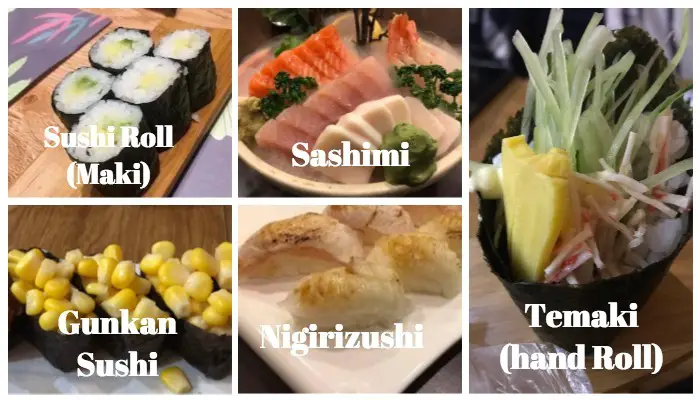
If you are visiting a sushi restaurant for the first time, be prepared to be overwhelmed by the different varieties of sushi on the menu. Which one would you pick – maki roll, nigirizushi, or gunkan sushi? If you are a non-Japanese, I don’t blame you! It happens with every first timer so it’s perfectly alright to ask, discover, and then order, or just trust the sushi chef serving you.
For most people, sushi is that ball of rice with dazzling orange (salmon) or red (tuna) colored raw fish on the top. They are blissfully unaware of the countless other varieties that exist! I once invited my non-Japanese friends for a sushi party at my home and they were so confused when they saw a hand roll (temaki). They never knew sushi could also look like this.
Their confusion, surprise, and mixed reactions made me wonder that there are so many people like them who don’t know the basic difference between different styles of sushi. It’s unfortunate for food lovers to not know and discover something that is so divine and delightful. But, don’t worry! You are now in safe hands!
In this article, I will tell you about the difference between the four main types of Japanese dishes that vary slightly in nature – nigiri, sushi roll (maki), gunkan sushi, sashimi, and hand roll sushi (temaki). The ingredients used in these dishes are common, with the exception of sashimi that only uses raw fish. The biggest difference lies in the way they are rolled or presented.
Ready to soak up some knowledge? So, let’s get started!
What Is Nigirizushi or Nigiri Sushi?
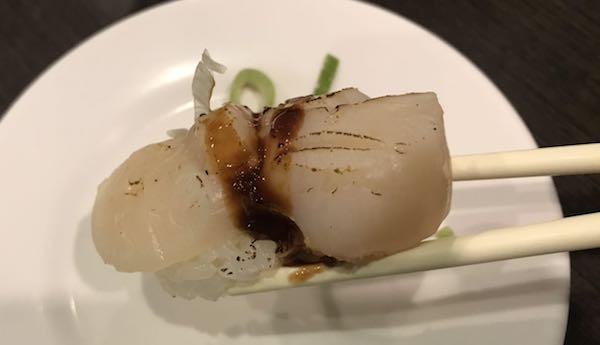
Nigiri (see detailed explanation) gets its name from the words ‘ni’ which means two and ‘giri’ which means fingers. It refers to the way the chef shapes the sushi by holding it between his two fingers. This is the most traditional form of sushi that most people imagine when they hear the name of this Japanese delicacy. It comprises of seasoned sushi rice topped with raw/ cooked/ grilled fish, seafood, egg, beef, or avocado.
At the restaurant, nigiri sushi is served in pairs in a sushi plate or wooden tray. They are bite size pieces that must be eaten at once. The most popular raw fish slices used in the dish are salmon and tuna. You must bite pickled ginger in between two pieces to cleanse your palate. If you are a beginner and not comfortable with eating raw fish, you may enjoy choosing the grilled or cooked toppings.
Raw fish is an acquired taste and may take some time for you to develop a liking for it. Try the traditional options at first and then proceed to the more complex flavors of squid and octopus. Making nigiri at home( click to see an ultimate guide) is easier than you think. To find out how to shape nigirizushi and the list of traditional and non-traditional nigiri toppings, see this guide.
What Is Sashimi?
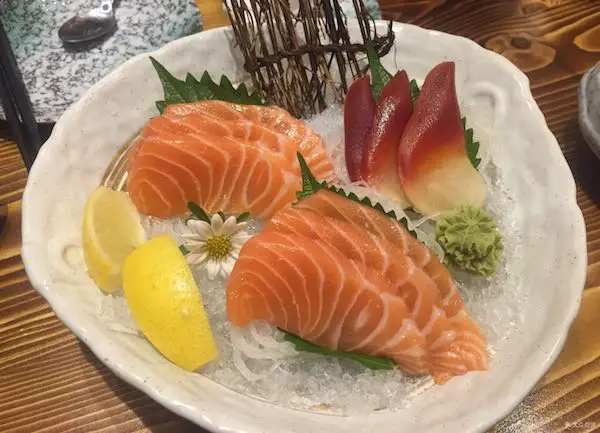
Nigiri and sashimi are often confused because they both contain raw fish slices but if you look closer you can find a stark difference between the two. Unlike nigiri, sashimi does not contain any sushi rice. It is just the raw fish slice without any seasoned rice, hence sashimi is not exactly sushi in the first place. The slices are aesthetically prepared from the freshest fish or appropriately frozen ones
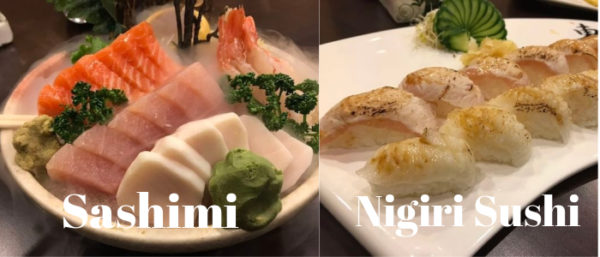
Sashimi is meant to only savor the rich, creamy, and buttery taste of raw fish. Besides being a culinary delight, this Japanese delicacy is also a treat for the eyes. The perfectly cut pieces of fresh raw fish look translucent and glisten like jewels. They often served with a bed of shredded daikon radish. If you want to make sashimi at home, you will need a sharp Japanese sushi knife like this for perfect thin slices of raw fish.
If you translate sashimi into English, it means pierced body/meat. It probably derived its name from the culinary tradition of sticking the tail and fin of a particular fish into the slices to identify the variety of fish being consumed.
Although sashimi traditionally involves pieces of raw fish with wasabi and pickled ginger, some places may also serve other raw meat like chicken, tofu skin or vegetables. However, the sashimi traditionalists believe that pure sashimi is only raw fish and nothing else.
What Is Sushi Roll (Maki)?
Maki is the Japanese term for sushi roll you can find in any sushi restaurant in Japan and other parts of the world. Unlike sashimi, it has many more ingredients than just a slice of raw fish. It comprises Nori (seaweed) for wrapping the roll, vinegared sushi rice that forms the base of the roll and holds the ingredients together, and the fillings that may be raw or cooked fish, seafood, meat, cucumber, avocado, etc.
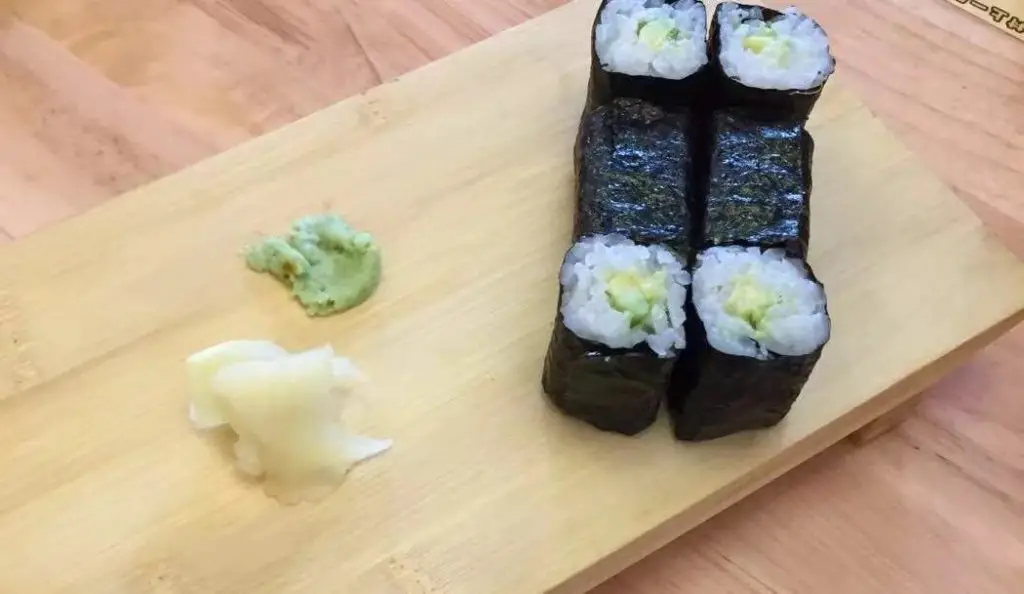
Sushi rolls can be of different types based on the varieties of fillings used. You may use just one filling or a combination of 2-3 fillings to get a fatter roll called futomaki. Sushi expert suggests beginners to avoid cramming the roll with many fillings as they can overpower the flavors of each other. To enjoy the taste to the fullest, use just one filling such as avocado slice, cucumber strip, or crab stick. Read on, if you are interested in making avocado rolls at home. I have spent 6 hours to write this article. You guys will like it.
You may pair avocado with cucumber to balance the soft texture of avocado or pair raw salmon with cucumber to add freshness to the roll. The vegetables and fruits used in a sushi roll must be sliced or diced in a particular fashion to make perfect rolls. Similarly, the raw fish should also be sushi-grade, bought only from a trusted fishmonger.

After the roll is shaped into a cylindrical form, it is cut into 6-8 equal pieces using a sharp Japanese knife. The pieces are best served in elegant looking Japanese sushi dinner set like this along with soy sauce and wasabi to enhance the flavor.
If you wish you make sushi roll (maki) at home, you will need sushi-grade fish, vegetables/ fruits of your choice, seasoned sushi rice (find the recipe here), Nori sheets, a bamboo mat for rolling, and a sharp knife. If you are a beginner, I would recommend you to use some of the best sushi making kits reviewed by me to make perfect sushi rolls every time!
What Is The Inside Out Roll or California Roll?
When talking about maki or sushi rolls, how can we forget the inside-out roll, also known as the California roll (see recipes)? This type of sushi roll came into existence when the Japanese delicacy made its way to the western countries.
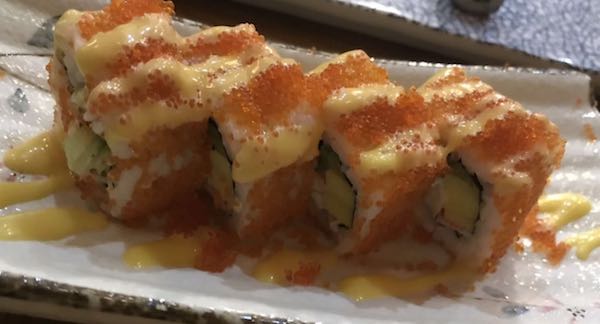
The westerners were not a fan of dark-green Nori, so the sushi chefs of that time flipped the sushi rolls to hide the Nori inside and decorate the exterior with delicious and colorful toppings. A Japanese sushi chef named Hidekazu Tojo is credited for inventing this style of roll that became popular with his Los Angeles patrons.
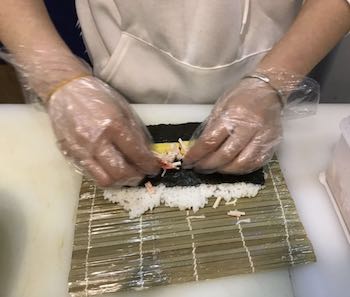
Today, there are different variations of California roll, in which the Nori is layered with sushi rice and flipped inside out to hide it. Similar to a traditional sushi roll, the fillings may include raw fish, seafood, grilled/ cooked meat, or vegetables and fruits. It may be topped with slices of raw fish or avocado to make the roll more appealing!
What Is Hand Roll (Temaki Sushi)
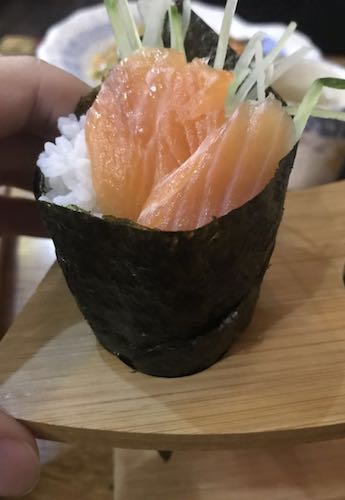
Just when you thought sushi rolls meant a cylindrical log consisting of sushi rice and fillings, cut into pieces, bam comes another surprise! Temaki sushi is the Japanese name for hand roll, and while it has everything you can expect in a traditional sushi roll, the difference lies in the way it is rolled.
Temaki sushi (see more detailed explanation) is different from sashimi in the sense that they are way more ingredients than a slice of raw sushi-grade fish. It is also strikingly different from a nigirizushi as it contains a Nori wrap and all other ingredients are beautifully arranged inside it.
Maki and Temaki can be made from almost the same set of ingredients. So, if you are throwing a sushi roll party or making rolls for dinner, you can always include Temaki sushi on the menu. The only big difference is that instead of making a cylindrical log, the Nori sheet is shaped like a cone.
Another difference is that the sushi rice is applied only to half section of the Nori, unlike a traditional roll where rice covers the entire area. Furthermore, a temaki sushi is not cut into pieces like a maki and it is meant to be eaten like a large sushi cone.
What Is Gunkan Sushi?
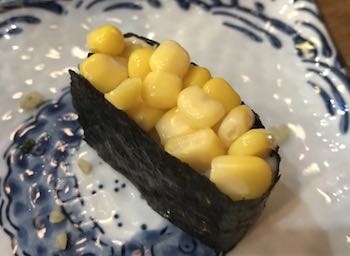
If you find the traditional form of a cylindrical log cut into pieces not so appealing, you can try this interesting form of sushi called gunkan. This is a Japanese term that translates to battleship in English, hence it is often called the battleship sushi. So, what makes gunkan sushi different from temaki or maki sushi?
Gunkan sushi comprises almost the same ingredients – vinegared sushi rice, salmon, and Nori wrap. The ‘surprise factor’ is flying fish roe that adds a special texture to this sushi. Flying fish roe are tasty and colorful eggs of fish, and they have a crunchy texture. The experience is similar to popping candies, and they leave behind a salty and smoky taste in the mouth.
To prepare this style of sushi, a strip of Nori sheet is wrapped around a ball of rice to form an oval boat shape. Now, you have a sturdy base on which you can arrange the fish eggs (just make sure there is enough space on the top to hold fish roe). While fish roe is the most common topping used in
Sushi Comparison Chart
| Name of Dish | Maki (sushi roll) | Temaki (hand roll) | Gunkan Sushi |
| Introduction | Maki refers to sushi rice and fillings (fish, seafood, meat, or veggies) wrapped inside a Nori sheet. | Temaki contains all the ingredients used in maki, but it is folded in a cone shape and eaten as one big sushi Gunkanmaki or battleship sushi contains a bed of sushi rice, topped with flying fish roe. It is wrapped with Nori to form a boat shape. | |
| Are the fillings raw or cooked? | Sushi rice is cooked. Fillings may be raw, cooked, grilled, or seared. | Sushi rice is cooked. Fillings may be raw, grilled, cooked, or seared. | Sushi rice is cooked. Fillings are mostly raw |
| Is it Sushi? | Yes | Yes | Yes |
| Does it always contain raw fish | Besides raw fish and seafood, you can find maki rolls containing avocado, cucumber, imitation crab, mango, carrots, sweet potato, and so on. | Strips of raw sushi-grade fish, cooked crabmeat, imitation crab, fried tempura, grilled prawn, veggies and fruits like cucumber, avocado, mango, etc | Traditional gunkan maki contains marinated flying fish roe, quail or oyster eggs; but you may also use chopped tuna, chopped salmon, sweet corn, diced avocado and cucumber. |
| Does it contain sushi rice? | Yes | Yes | Yes |
| Served with | Pickled ginger and soy sauce | Pickled ginger and soy sauce | Pickled ginger, wasabi and soy sauce |
| Garnished with | May be sprinkled with sesame seeds and topped with avocado slices or raw fish in case of California roll | May be garnished with flying fish roe and toasted sesame seeds | May be garnished with chopped spring onions |
| Eaten with | Hands or chopsticks | Hands | Hands or chopsticks |
Nigiri Sushi and Sashimi Comparison Chart
| Name of Dish | Nigirizushi (Nigiri Sushi) | Sashimi |
| Introduction | Nigirizushi is a type of sushi made of thin slices of raw fish placed over pressed seasoned sushi rice. | Sashimi is thinly sliced raw fish, such as salmon or tuna that is served without rice. It may also be slices of other raw meat like beef, chicken, and frog |
| Are the fillings raw or cooked? | Mostly raw, but you may also find nigiri made with cooked or seared fish | The fish or meat is always served raw |
| Is it Sushi? | Yes | No |
| Does it always contain raw fish | Mostly, nigiri is topped with 1/8 inch slice of raw fish and other seafood such as shrimp, octopus, and squid. You may also use veggie options like avocado. | Other than fresh fish, sashimi may also be thin slices of meat, like beef, chicken, horse, or frog. |
| Does it contain sushi rice? | Yes | No |
| Served with | Pickled ginger, wasabi and soy sauce | Pickled ginger, wasabi and soy sauce |
| Garnished with | Usually nothing, except soy sauce at times if the chef so fancies | Daikon radish shreds , shiso leaves, and other sauces |
| Eaten with | Hands or chopsticks | Chopsticks |
The Final Words
Sushi has come a long way from its humble beginning and today there are way more options to roll and varieties of fillings and toppings than you can probably think of! The best part is that making sushi at home is extremely easy if you have the right tools and ingredients available.
For beginners, I would suggest that you start with nigiri or sushi roll containing cooked/ grilled meat or raw veggies. Slowly proceed with raw fish paired with avocado or cucumber slices inside the roll to balance the flavor. It may take some time to develop taste but once you do, you can go ahead and try different types of sashimi!
No matter which type of sushi you prefer to make at home, remember that serving and presentation carries extra points. Serve the pieces in beautiful traditional Japanese sushi dinnerware set. To check out my review of some of the best sushi dinnerware sets, visit this page.

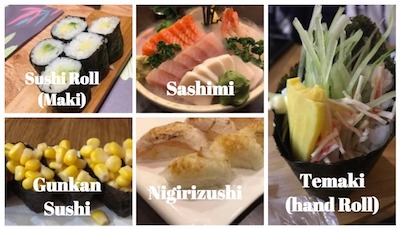
Comments
Pingback: Nigiri Sushi: All you Need To Know - Easy Homemade Sushi
Pingback: Does Sushi have to have Rice? - Easy Homemade Sushi
Pingback: Is Sushi Seafood? Revealing the Truth - Easy Homemade Sushi